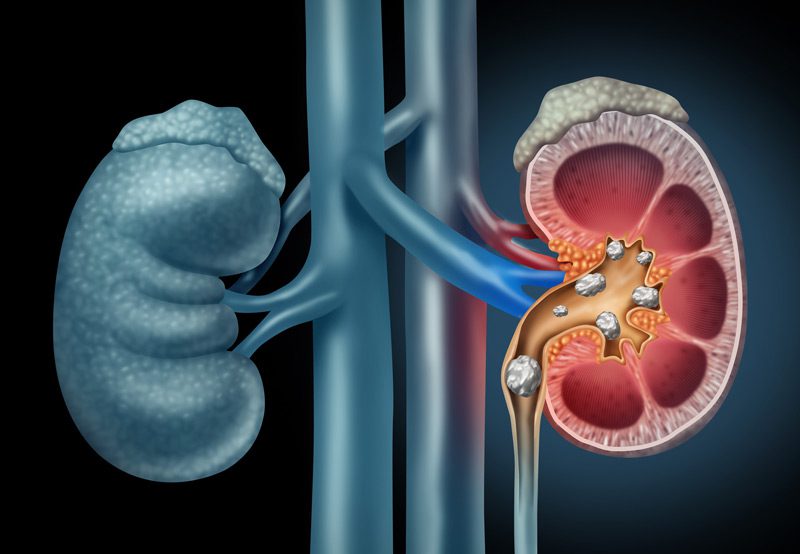

Kidney stone disease occurs when minerals found in urine develop into hardened deposits. The stones may vary in size, ranging from a grain of sand to a golf ball. Kidney stones may remain in the kidneys, or they may pass through the urinary tract and cause severe pain. Patients passing kidney stones may experience pain in the back, side, or pelvis as the stones travel to the bladder.
Causes of Kidney Stones
Overweight individuals are more likely to develop kidney stones; however, the condition may also be inherited.
A significant change in the natural balance of water, minerals, and other substances typically found in urine may cause kidney stones to form. Dehydration may also cause kidney stones. Low levels of water leads to low urine flow, creating an environment for kidney stones to form. Conditions like diabetes and gout may also cause patients to develop kidney stones.

Signs and Symptoms of Kidney Stones
Kidney stones that don’t leave the kidneys cause little to no discomfort. Patients may experience sudden and severe pain if the stones move through the urinary tract. Pain may worsen if the stones become lodged in the ureters, which are the tubes that connect the kidneys to the bladder.
Other symptoms of kidney stones include:
- Fever and chills
- Blood in the urine
- Nausea
- Vomiting
- Cloudy or odorous urine
- Severe pain in the stomach, side, or lower back
- Frequent urination or an urgent need to go
- Painful urination that may include burning sensations
Diagnosing and Treating Kidney Stones
Patients experiencing symptoms of kidney stones will need to undergo imaging studies, such as a CT scan, radiograph, or kidney ultrasound. A CT scan has the highest sensitivity and specificity in visualizing and detecting kidney stones.
Once a kidney stone has been identified, patients may choose between a trial passage or surgical intervention. A trial passage involves having the patient attempt to pass the stone spontaneously, sometimes with the help of pharmacological therapy. If the patient is unable to pass the kidney stone, they will undergo surgery to remove the stone.
Patients with small kidney stones may undergo shock wave lithotripsy (SWL), which involves the use of shock waves to break down stones and make it easier for the patient to pass the stone naturally.
During the procedure, a flexible tube with a light and camera at the tip is inserted into the urethra and bladder. Once the stone is located, a laser will be used to break the stone into smaller pieces. A tiny wire basket may be used simultaneously to collect and remove the stone’s fragments. If the particles are the size of dust, the patient will pass them spontaneously.
Patients with larger stones will require a percutaneous approach through the back. Also called percutaneous nephrolithotomy (PCNL), the procedure has become the gold standard for treating larger stones.
In some cases, a stent may be used to provide temporary relief to an obstructed kidney or to keep the ureter open after surgery. A stent must be removed or exchanged after initial placement.

